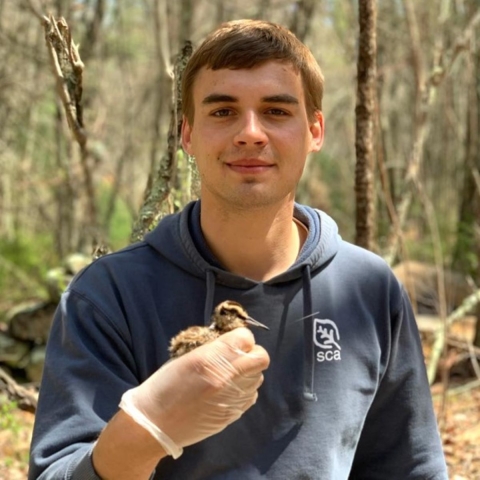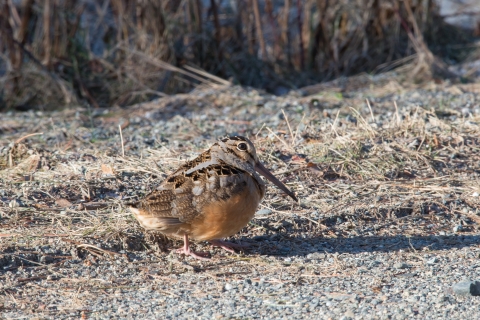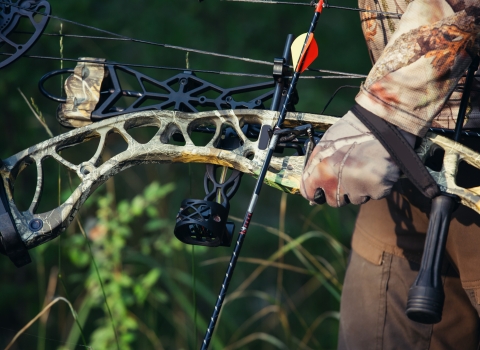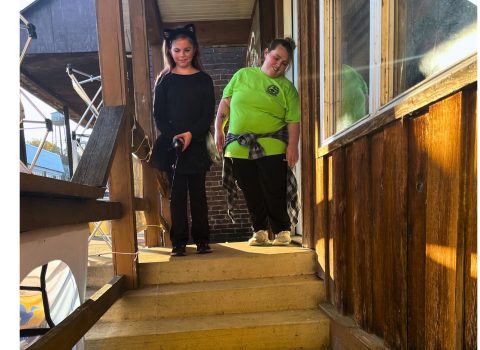Colby Slezak is the U. S. Fish and Wildlife Service’s Library’s latest FWS Scholar who has recently published peer-reviewed scientific literature on the life-history, ecology, and management of the American woodcock (Scolopax minor). Whether it’s studying upland game birds, managing habitats, or collaborating with partners, Colby’s goal is to make a lasting impact on the conservation and management of wildlife and their environments.
He is a fish and wildlife biologist at the Utah Ecological Services Field Office in Salt Lake City, Utah where he is passionate about conserving and restoring natural ecosystems to support diverse wildlife populations. His work is focused on understanding species’ ecological needs and developing strategies that balance conservation with sustainable land use.
Colby is originally from New York and his growing up years included lots of camping, hiking, hunting, and fishing in the Adirondack mountains of upstate New York. Those early experiences developed his passion and appreciation for wildlife and the outdoors. He was fascinated with understanding why animals move and behave the way they do. One animal that captivated him was the American moose (Alces Americanus); they are huge, majestic, and surprisingly secretive as they quietly move throughout the forests of the Adirondacks.Colby shares, “The opportunity to work closely with wildlife and contribute to their conservation has always been a driving force in my career.” He’s especially passionate about understanding the life-history of avian species and utilizing that knowledge to improve habitat management.
Colby earned his Bachelor of Technology in Wildlife Management from the State University of New York at Cobleskill (SUNY Cobleskill) in 2019. More recently, he completed a PhD in Biological and Environmental Science at the University of Rhode Island in 2024. At URI, Colby studied under Dr. Scott McWilliams and his research focused on the migration and breeding ecology of the woodcock. “Wildlife conservation is important to me because it allows me to contribute directly to on the ground management and implement recovery strategies to ensure species persistence,” Colby explains. His recent research focuses on the life-history, ecology, and management of the American woodcock.
The American woodcock is a popular migratory gamebird throughout eastern North America. This shorebird is plump and perfectly camouflaged against leaf litter with its buff, brown, and black plumage. It spends most of its time hidden in fields, on the forest floor, or in wet meadows probing its long straight bill to find earthworms and other invertebrates.
In the early spring, they’re easiest to find at dusk, when males begin their courtship displays-sky dancing in dim light. One of the USFWS Library’s favorite pieces of classic conservation literature is Aldo Leopold’s famous book, A Sandy County Almanac. In it, Aldo Leopold dedicates an entire essay to the woodcock titled, Sky Dance. He described what he saw:
“Suddenly the peenting ceases and the bird flutters skyward in a series of wide spirals, emitting a musical twitter. Up and up, he goes, the spirals steeper and smaller, the twittering louder and louder, until the performer is the only speck in the sky. Then, without warning, he tumbles like a crippled plane, giving voice in a soft liquid warble that a March bluebird might envy.”
It's a dramatic and dazzling natural sight, one that Leopold made it a point to watch whenever he could.
Colby’s research was conducted through collaborative efforts with the University of Rhode Island, the Rhode Island Department of Environmental Management, and the Eastern Woodcock Migration Research Cooperative (EWMRC). The EWMRC brings together state, federal, and NGO partners across the U.S. and Canada to investigate woodcock migration, breeding, and habitat use using satellite GPS tracking. This large-scale research offers key insights into the movement patterns, survival, and management needs of this declining species. Woodcock populations have experienced significant declines since the mid-1960s. Recent declines may be related to degradation of early succession forest habitat, land use changes, current forest management practices, and exposure to pesticides. Colby’s research is especially meaningful, as it focuses on a declining species and provides critical information that can be used to guide conservation efforts. Being able to apply scientific knowledge to real-world management strategies is what drives his passion for this work.
In Colby’s most recent paper, "Unconventional life history in a migratory shorebird: desegregating reproduction and migration", published in Proceedings of the Royal Society B (2024) he provides the first evidence of itinerant breeding, a rare behavior in migratory birds where migration and reproduction overlap. This challenges conventional life-history, which suggests that migration and reproduction, two of the most demanding and energetically expensive periods of the annual cycle cannot overlap. For woodcock, this research highlights the importance of flyway scale habitat management and monitoring of reproductive success, given the extensive movements that occurs between nesting attempts.
Another recently published paper, "Sex-specific differences and long-term trends in habitat selection of American woodcock", published in the Journal of Wildlife Management (2024), examines habitat selection over time for male American woodcock and makes direct comparisons between male and female habitat selection at the same temporal and spatial scales. This researched filled critical gaps in our understanding of woodcock, particularly when it comes to female woodcock that are especially cryptic and challenging to study. Colby developed habitat selection models and relative probability of use maps using very high frequency (VHF) tracking data and geographical information system (GIS) habitat layers that provided Rhode Island with a set of tools that can help managers to decide where habitat management is most beneficial to woodcock.
Colby is also a coauthor on several papers from the EWMRC, including "The American Woodcock Singing Ground Survey largely conforms to the phenology of male woodcock migration", published in the Journal of Wildlife Management (2023), which examines the timing of woodcock singing behavior in coincidence with the American Woodcock singing-ground survey routes, a long-term effort by the USFWS to monitor woodcock population trends and restore populations to that of those in the early 1970’s, and "Satellite Tracking of American Woodcock reveals a gradient of migration strategies", published in Ornithology (2024), which describes the diverse migration strategies and behaviors of woodcock and the potential for this species to adapt to environmental change.
Looking ahead, our prolific FWS scholar has two forthcoming papers. The first, "Mismatch between strong nest site selection and low survival of nests and broods for American woodcock and its implications for conservation" has been accepted in Ornithological Applications, and examines the survival challenges nesting woodcock and broods face despite selecting concealed nest sites. The second, "High post-breeding survival for male American woodcock based on long-term tracking: a case study from Rhode Island, USA", investigates woodcock survival in Rhode Island using a decade of VHF tracking data. Both studies aim to address key gaps in woodcock population dynamics and provide guidance on their conservation and recovery.
Currently, Colby is a fish and wildlife biologist at the Utah Ecological Services Field Office in Salt Lake City, Utah. As a new Fish and Wildlife Biologist working on migratory bird policy, he is excited to connect science to policy and ensure the persistence of declining, threatened, or endangered bird species including bald eagles, golden eagles, and pinyon jays.He says, “I look forward to translating research findings into actionable conservation strategies that can enhance and protect migratory bird populations. Working in this role will allow me to influence meaningful change at a landscape scale, combining my love for wildlife with a strong commitment to preserving biodiversity for future generations.”
Learn More
To learn more about Colby and his research, view this full list of publications.
Some ways that you can get involved in helping woodcock includes creating early successional habitat or young forest. Loss of this habitat is one of the reasons researchers think woodcock have declined. Much of the land within the woodcock's range is held under private landownership so landowners can really make a difference. Shrubs and trees can be planted, or if they already grow in a given area, consider periodically harvesting large trees, which may be shading brush or stunting the growth of younger trees. Even small forest openings < 1 acre can attract singing males in the spring. Visit the young forest’s initiative from more information on woodcock habitat needs.
Through research, woodcocks are an effective umbrella species, which means management for woodcock helps a diversity of songbird and mammal species, particularly the New England cottontail. Primarily because, habitat mosaics for woodcock must include forest openings as well as mature forest and wetlands. If you’d like to continue learning about American woodcocks, check out the species profile page.
Brought to you by the U.S. Fish and Wildlife Service Library
The USFWS Library serves the Fish and Wildlife Service community to support research, learning, and science excellence. We are connecting USFWS scientists to library resources worldwide via library.fws.gov. The FWS Scholar series highlights Service employees in the field who have contributed to scientific research and the work of conservation. If you are a USFWS employee who has recently published peer-reviewed scientific literature and would like to share your research with others, email us at library@fws.gov.









